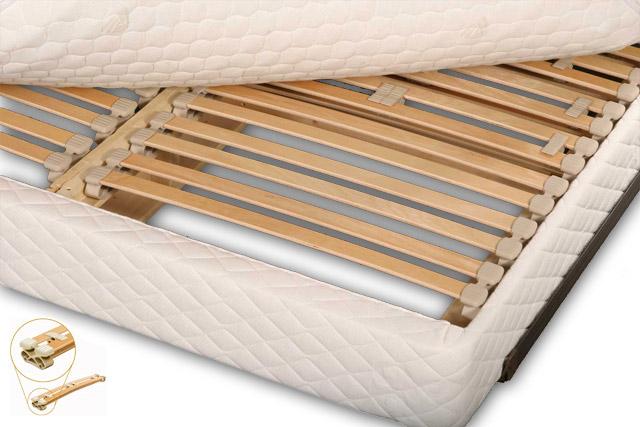If you've ever been curious about what a boxspring is actually for, or you're trying to determine if your platform bed or existing boxspring will work with one of our mattresses, this guide is for you!
What is the purpose of a boxspring?
Today, the type of boxspring sold with a mass produced mattress is merely intended to provide a raised surface for the mattress to rest on. A typical modern boxspring no longer has "spring" - it is usually a rigid platform made out of a thin grid of metal wires built on a light weight pallet bottom; typically with a thin layer of paperboard or even cardboard as an insulation material over the metal wires.
This is different with a high quality sleep system such as our offerings from Berkeley Ergonomics and Harrison Spinks. Each of these mattress makers offer functional suspension foundations which are designed to provide enhanced ergonomics and additional pressure relief. How? These foundations have movable components, which absorb and dissipate energy. This extends the life of the mattress as they work like a shock absorber on a vehicle, reducing wear and tear.
Critically, our suspension foundations are also breathable, allowing optimal air circulation. This reduces the possibility of mold or mildew forming between the mattress and box, and helps to prevent the sleeper from overheating.
When we consider that the three most important attributes of creating the ideal mattress, we can easily see that a suspension foundation is critically important to achieving these goals:
- A mattress must provide correct spinal alignment.
- A mattress must provide adequate pressure relief.
- A mattress must regulate temperature and humidity.
Rigid foundations are not ideal
Correct spinal alignment and pressure relief are a package deal. The mattress
itself must to conform to the complex shape of the body in order to provide full body support as well as optimal weight distribution to minimize pressure points. Even if one has a very flexible and elastic mattress the biggest restriction that can prevent a mattress from fulfilling this demanding role, is a rigid and unyielding base. A well designed suspension system can move with the mattress to enhance its ability to perform both tasks; providing superior spinal alignment and pressure relief. For these reasons, a suspension foundation is worth the investment and should be used wherever possible, regardless of mattress type or brand.
Will I void my mattress warranty if I do not buy the boxspring?
Not necessarily. Mattress stores tend to suggest that by not buying the matching boxspring that somehow the mattress warranty is automatically voided. This is simply not true. However, the mattress manufacturer does have the option to void your warranty if they determine the existing boxspring or platform bed is not providing adequate support.
This guide will walk you through the steps to determining if your platform bed or boxspring is adequate for your mattress.
How do I determine if my existing boxspring will work?
If you are going to be placing a new mattress on an existing boxspring, there are two simple things to look for:
- A flat, rigid surface without any sagging or dipping
- A non-flexible, rigid construction (push on the edge of the base, if it moves down, it's probably not the right type for most modern mattresses)
- Sufficient surface area to support the mattress properly - the heavier and more flexible a mattress is the narrower the gaps in support ought to be
Although we talk about suspension foundations being the best type, you'll want to avoid a box with actual springs in it; at least if you're buying a natural rubber, latex or memory foam mattress. A box with flexible springs is best suited for a mattress with springs, and even then, only if the spring system in both components is engineered to work in tandem. Harrison Spinks mattresses are a great example of a spring box providing superior performance versus a rigid box or slats. The Harrison Spinks Premium 4200 Base offers approximately 4,200 springs in queen size (5,100 in king) and acts as a shock absorber for the mattress.
In most cases, we recommend buying the matching boxspring when buying a new mattress. If after reading this guide you decide a simple rigid foundation will suit your needs best, our Berkeley Ergonomics standard slat foundation is universally compatible with all mattress brands.
Platform Beds
Platform style beds are designed for use with a mattress only. Instead of a boxspring, the platform will often have wooden slats or a board to place the mattress on.
If you have a platform style bed, these are our basic criteria for a good support system:
- Rigid, flat wooden slats ideally made of spruce or poplar at a minimum (pine isn't usually the best idea). In a perfect world the slats would be a hardwood such as beech or oak.
- Slats which are spaced no further than 2" apart for heavier natural rubber or latex mattresses, 3" spacing with a memory foam mattress is usually fine.
- Queen and king platforms must have at least one centre rail or beam that runs head to foot, which is also supported by legs extending to the floor. The more legs the better!
- Queen and king platforms which do not have a centre beam should have T-slats - a flat top board, with a heavy duty support. A good example of this system is from Copeland Furniture.
- Double platforms should have a centre beam, however a set of slats with 3 legs extending to the floor are also usually adequate.
A platform bed support system should not be as follows:
- A solid platform, without ventilation although with our Berkeley Hybrid / Harrison Spinks mattresses this is not a major concern as the mattresses have an amazing capacity for airflow
- Slatted without any sort of centre support or centre legs (twin beds are usually fine when designed this way).
- Slats which are spaced too far apart (ie: more than 2 ½") - foam mattresses in particular will follow the gaps and sag easily into these openings.
- Bowed slats, unless they are the genuine European beech wood variety, with extra slats in the middle and bushings for proper suspension.
In our experience over the years, most bowed slats are not designed correctly. They look pretty, but often sag easily under the weight of any decent mattress. An easy way to test this is to press down firmly on the bowed slat. It should go flat, if it extends down below the level plane of the frame, this means it will not provide adequate support. This is because most bowed slats are mounted in a simple rubber sleeve but have no suspension or reinforcement of their own. This allows a heavier more flexible mattress (very normal with TMASC) to compress the slats to be concave rather than convex, creating a hammocking effect.
The best bowed slat support systems are made of laminated hard wood (typically Beech) - and most importantly they will be mounted on top of suspension style anchors which allow the ends of the slat to compress and the entire slats to pivot and contour with the weight of the sleeper, these will also ideally have extra supports in the middle of the bed so heavier parts of the body are better supported without hammocking.
Examples of Poor Slat Designs
These photos show examples of poor, inadequate slat designs. These slats should be avoided with any heavier, higher quality mattress. All of these systems have in common a simple plastic sleeve that is hard mounted to rigid surfaces. This means all of the flexing of these systems is only the wood slats themselves, under heavier loads (particularly with heavier, high quality mattresses that are more flexible) these slats will go from being convex in shape to concave. Giving the perception of laying in a trough.

Slats are spaced too far apart, and are missing the "third slat" beneath the top layer.

These are some of the worst-designed slats that we have ever encountered. Three sections, which means that each sleeper is now sleeping on the rigid spine in the middle of each suspension portion. Absolutely not ideal whatsoever.
Example of Correct Slat Designs

These Berkeley suspension slats correctly incorporate the "third slat" beneath the top layer. These slats must be under the heavier parts of our body to provide adequate support. The rubber bushing system used allows the slats to pivot and help the mattress contour the body. These bushings also reduce the amount of give in the slats themselves, preventing them from becoming concave even under heavy loads.

The slat spacing at the head and foot of the bed is still very tight, although the third slat is not required in these portions of the bed. Additional rubber bushings for the middle section of the base can be adjusted to provide more control over your weight distribution and help to correct potential posture issues.
IKEA Platform Beds
If you have an Ikea platform bed, we do not recommend their LEIRSUND, LURÖY or LÖNSET bowed slat foundations for any heavy foam mattresses, including most latex and some memory foam models. The LEIRSUND and LÖNSET slats are reasonably okay to use with hybrid spring mattresses, for lighter sleepers.
In our testing, we find that heavier mattresses, especially our natural latex mattresses from Berkeley Ergonomics and Obasan, simply do not work well on the bowed Ikea slats. Our customers have reported sagging and dipping of their mattress, in some cases after one night.
Well engineered bowed slat systems, such as the suspension slat model we offer from Berkeley Ergonomics, work perfectly as a replacement for the Ikea slat system. Alternatively, the Berkeley standard slat foundation is also offered in a low-profile version that will fit in IKEA platform beds.
Platform Beds from Furniture Stores
We strongly caution you to investigate the included mattress support. While many platform beds are well-made, our experiences over the years have demonstrated that many of these beds, no matter how much they might cost, are often including substandard slat systems as this component of the platform bed is often an afterthought or may never been shown in photography of the product in question.
The Mattress & Sleep Company will gladly provide advice on any mattress support system with respect to their positive or negative impact on any of our mattress offerings.

